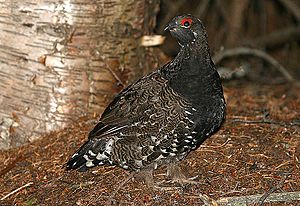Franklin's grouse facts for kids
Quick facts for kids Franklin's grouse |
|
|---|---|
 |
|
| Franklin's grouse | |
| Conservation status | |
| Scientific classification | |
| Genus: |
Falcipennis
|
| Species: |
franklinii
|
| Synonyms | |
|
|
The Franklin's grouse (Falcipennis franklinii) is a fascinating bird found in the forests of British Columbia and the Rocky Mountains. It's a type of grouse, which are birds known for living mostly on the ground.
About Its Name
For many years, the Franklin's grouse was considered a special kind of spruce grouse. It was called a "subspecies," which means it was a distinct group within the larger spruce grouse species. Imagine different types of apples; they are all apples, but they have unique features.
In 2014, a group called the IUCN decided that the Franklin's grouse was unique enough to be its own separate species. However, other bird groups, like the International Ornithological Congress (IOC), still consider it a subspecies of the spruce grouse.
There is also a special group of Franklin's grouse called F. f. isleibi. You can find these birds on Prince of Wales Island and nearby islands in southeast Alaska.
What It Looks Like
The Franklin's grouse looks a lot like its close relative, the spruce grouse. But there's one easy way to tell them apart! The male Franklin's grouse has a tail that is completely black. It doesn't have the reddish-brown band at the end that the spruce grouse has. Instead, the Franklin's grouse has white spots on its black tail.
How It Behaves
Male Franklin's grouse are known for a cool trick called a "wing-clap display." This is how they show other birds that an area is their territory.
When a male grouse does this display, it takes a short flight through the trees. At the end of the flight, it brings its wings together over its back. This makes two loud, sharp claps! These claps happen about half a second apart. They are loud enough for a person to hear them from about 150 meters away.
Sometimes, if you clap your hands in a similar way, a male grouse might even clap back! This special display helps scientists find where the male grouse live. It also helps them figure out how many grouse are in an area.


